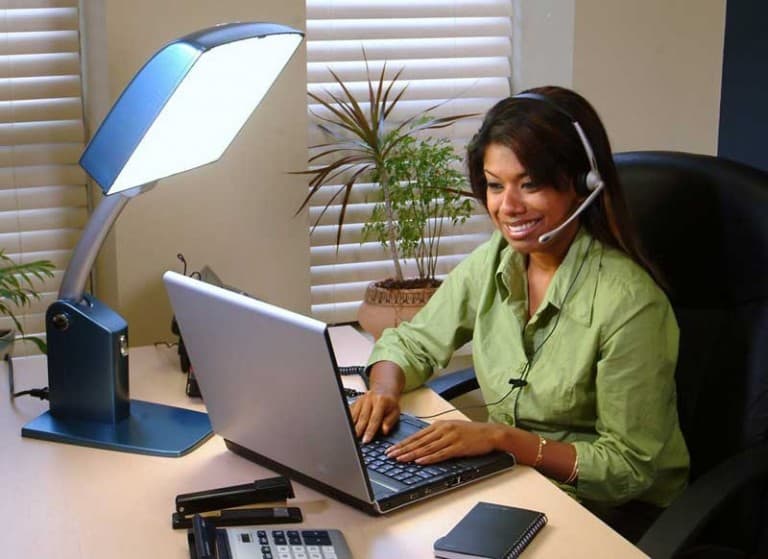Does winter gloom affect you? Dark, short winter days, ridden of substantial sunlight can cause you to feel tired, lethargic, moody, and depressed.
The lack of sunlight may also be the reason you have trouble falling asleep at night. Or that you sleep, and eat, more than normal. I know what you’re struggling with. Where I live, the fall/winter period tends to last from September until mid April and it messes up my Circadian rhythm.
Feeling depressed during the winter period causes many people to use antidepressants but for most people this less invasive option is likely to be a better solution.
In the absence of sufficient sunlight we can rely on SAD therapy lights to ensure our brain releases serotonin. Normally your body produces this chemical in reaction to sun light exposure. But artificial light works too, as various studies on light therapy treatment of seasonal affective disorder (SAD) show.
Serotonin helps us wake up in the morning, feel energetic and optimistic. A deficiency can lead to winter depression.
Serotonin, a.k.a. the happy chemical, scientific name: 5-hydroxytryptamine, or 5-HT, regulates your body clock, sleep wake cycle and perceived wellbeing
Night shift workers may suffer from the same symptoms as those who have the fall-onset winter blues. Their ordeal is is called; Shift Work Disorder (SWD) or Delayed Sleep Phase Syndrome (DSPS).
As a neurotransmitter/hormone, serotonin does more. It regulates bowel movements and sexual function, reduces anxiety, among other things. Since low serotonin levels are directly linked to depression, boosting serotonin levels can help alleviate symptoms.
Increasing serotonin levels can be done via medication, diet, exercise, psychotherapy, and also one of the first-line treatments, light therapy. Combating the winter blues specifically can also be done via melatonin pills.
Doctor-recommended SAD lights that emit full spectrum (white light) and a specific bandwidth of blue light help combat winter depression by imitating sunlight.
Critical to satisfactory light therapy is obtaining a high-quality light box that is adequate. This depends on the bulbs and the screen filter.
Which is the best SAD Light Box to buy?
This depends on your specific situation and needs. Choose based on where you intend to use it, whether you think blue or white light is best for you, and if you want to be able to do other things while using it. Below are the most popular, well-reviewed devices, each with its own distinctive features.
Reviews: Top 5 best rated SAD Light Therapy Lamps
1. Lightphoria, 10,000 Lux Energy Light Lamp
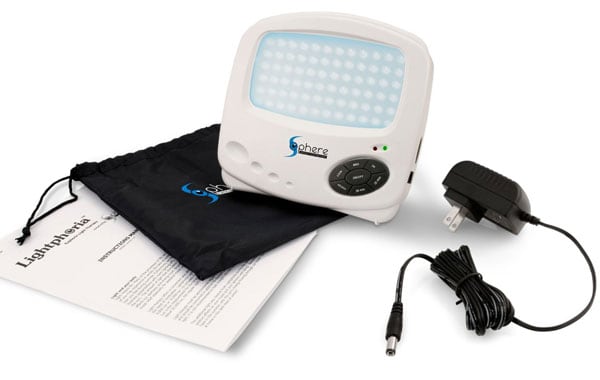
If you’re looking for a truly portable, small device this light by Sphere Gadget Technologies is the way to go. Yes it’s small but it’s bright enough to pull people out of their doom and gloom.
Pros
- brightness adjustment
- portable, it’s lightweight and small so it can be used as a travel SAD box too
- the smallest of the top models, (tiny actually compared with some of its competitors) taking up almost no desk space
- emits the required 10,000 lux
- 15, 30 or 45 minutes timer feature
- energy-saving LED bulbs that don’t heat up
Cons
- ‘plasticky’; not as robust as one would expect from a device that comes with a travel pouch
2. SunTouch Plus Light and Ion Therapy Lamp
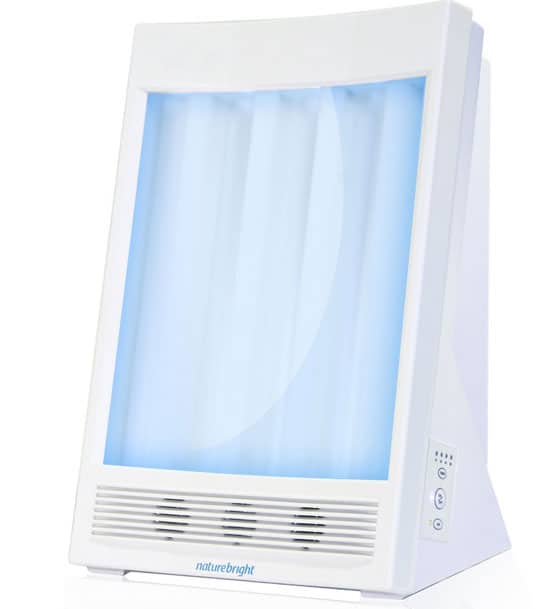
It has the looks of a facial UV tanning light but no worries, it has an UV filter, emits the required 10,000-lux of white light and offers an optional aroma therapy feature.
Pros
- affordable
- timer
- effective
Cons
- Replacement bulbs are pricey and will increase cost of use over a period of a few years
- Comes with an ion therapy lamp which may emit harmful ozone. This feature can be turned off though.
- Similar to Himalayan pink salt lamps that are praised for their negative ion emitting abilities, this feature is merely based on bunk science.
3. Philips GoLITE BLU Energy Light
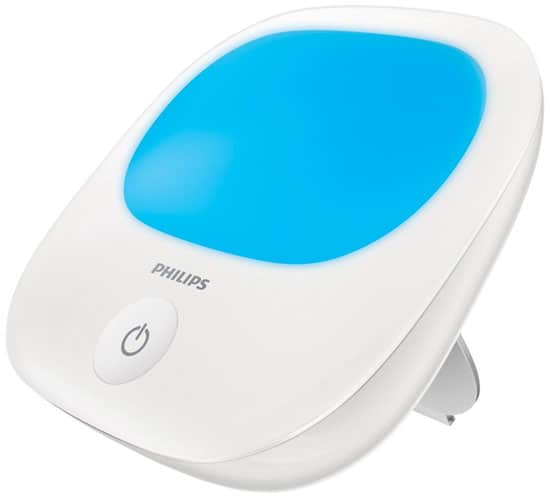
Opting for a blue SAD light? Studies show blue light is the most energizing hue on the spectrum. The goLITE BLU emits 200 lux of blue light which is proven similar to 10,000 lux of white light. No worries about light intensity, it is extremely bright and does its job.
This device with its soft blue LED is energy-efficient, completely UV-free and can be used both cordless as well as plugged in.
Pros
- portable
- low energy costs
- effective
- rechargeable battery-operated and corded version
Cons
- no timer
- stand could be more robust
4. Verilux HappyLight Liberty 10,000 LUX
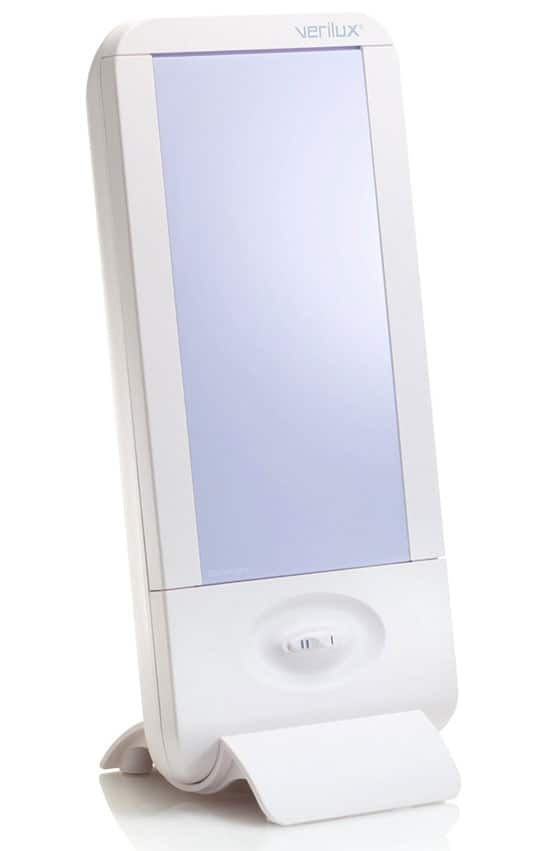
This full spectrum LED device is especially suitable for those who want to adjust light intensity. It has two different brightness levels and comes with two lenses so you can choose between four intensities in total.
It can be tilted back and forth to make sure the light comes from above. This product has pretty much only raving, 5 star reviews and is almost guaranteed to help you combat the winter blues. The HappyLight emits 6,500 kelvin which is slightly on the cooler end.
Pros
- multiple light intensity settings (10k, 7.5k, 5k, 3.5k lux)
- tilt feature
- glare cover
- lightweight
- you don’t have to sit directly in front of it
Cons
- no timer
- no dimmer
- the percentage of UV filtration isn’t known
5. Carex Day-Light Sky Bright Light Therapy Lamp
recommended by the Center for Environmental Therapeutics
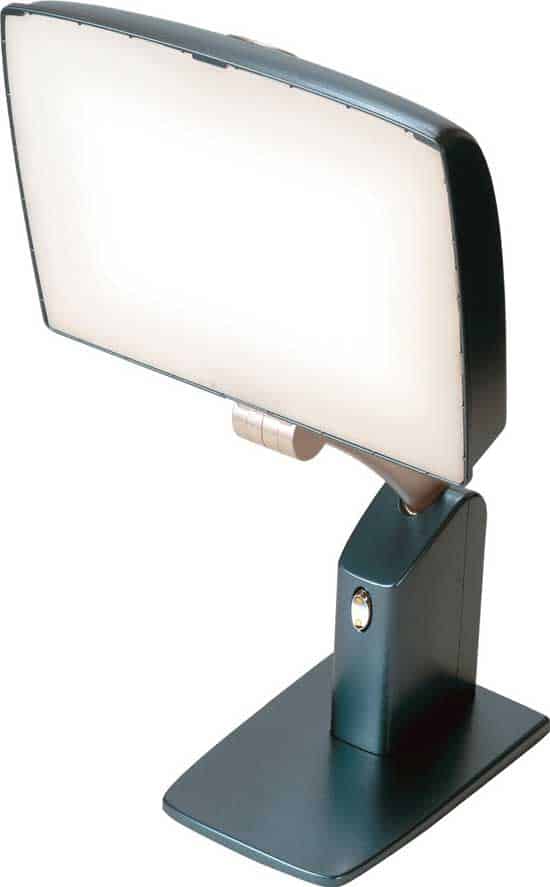
If you’re looking for a therapy / task light combo this may be your best bet. When turned on for treatment it will, after a set time, automatically fade to a lower task light setting.
More importantly, this light box has been commonly used by researchers studying the effects of light exposure on jet lag, Shift Work Adjustment, Circadian Sleep Disorders, seasonal lethargy and more.
Research indicates that the light coming from above (similar to sunlight) increases efficacy. This box’s height and angle can be effortlessly adjusted to do just that, optimizing efficacy. It emits 4,000 kelvin which has a warmer ‘feel’ than most of its competitors.
The advantage of using a big light box is that even when you’re moving your head slightly away from the box, your eyes are still in the therapeutic range of the device. With smaller boxes less so.
Pros
- clinical studies have proven this light box to be effective in treating SAD symptoms
- functions as a task light
- high quality light; no glare or flickering
- sturdy build
- 99.3% UV blocked for eye and skin safety
Cons
- bulky
- heavy, which makes it stable, but not easily portable
SAD Light Therapy Lamp Buying Guide
FAQ: What you should know about SAD light therapy devices
Don’t be tricked into buying so called SAD bulbs. If you search on, for instance Amazon, for ‘SAD light bulb’, a wide range of full spectrum bulbs pop up. This may cause the impression that these day light bulbs function as SAD therapy devices but they do not. This is because they do not emit the standard 10k lux needed for effective SAD therapy.
How to recognize a reputable brand? Well obviously positive user reviews are an indication of quality but an additional indicator is the following. Check if the manufacturer informs about the recommended distance the light should be used. This is essential to get the proper amount of light (lux). If this is not communicated I’d go for a brand that does list this information.
Make sure to get a doctor recommended / ‘prescription strength’ 10,000 LUX light therapy box. Less light intensity is not sufficient for treating seasonal affective disorder. Research indicates that 15-30 minutes at 10,000 lux typically offers the therapeutic value. This does not go for all devices.
How to use? The Center for Environmental Therapeutics recommends placing the light box at or above your line of sight to ensure the light is projected downward to the eyes.
Inform at your insurance company about coverage. They may cover purchasing a light therapy lamp.
Energy use. If this is an issue for you consider getting an eco-friendly LED powered SAD light.
How long till it starts working? Generally, it takes a few days to a few weeks for positive effects to become noticeable.
With so many lamps to choose from, how do you know which one to pick?
How much lux do you need?
Most SAD lamps do what they’re intended to do but the time you have to spend behind it varies. As a general guideline: make sure it emits at least the commonly recommended 10.000 lux light intensity because this makes things more convenient for you.
The more lux it emits, the less time you have to spend behind a light box. And you can sit at a larger distance from the box. Which can be a decisive factor in case you’d want to be able to multitask, for instance, do some work during light therapy. Which is difficult if you have to keep your face close to the light all the time.
Lux vs. lumens
Keep in mind that lumens indicate how much light a lamp produces. Lux are a measure of brightness perceived by your eyes. It’s the dosage, the amount of light you actually get.
Other things to keep in mind, although less critical, are bulb replacement (light intensity degrades after years of use) and size and features. More in a bit.
What about light color? White vs blue vs full spectrum light
Should you also take the Kelvin value, aka color temperature into consideration? It was long thought that as long as the device emits white light, sufficient light intensity (lux) is all that matters.
However, more recent research shows that the human circadian system is especially sensitive to blue light. Thus indicating that color temperature could be relevant.
- Low-intensity blue-enriched white light (750 lux) and standard bright light (10 000 lux) are equally effective in treating SAD. (Meesters, Y. et al. 2011)
- Short wavelength (blue) light is particularly effective at regulating the circadian system. (Rea et. al, 2002).
Blue-enriched light allowed test persons to spend 20 minutes on therapy daily, whereas the control group received 30 minutes of standard bright light treatment daily, both groups’s symptoms improved similarly.
blue light therapy reduced overall treatment time
Why blue light is not for everyone..
Most SAD therapy boxes emit white light, some (mostly LED’s) utilize blue light. White light is often perceived as milder.
Blue light mimics natural day light. If you’re sensitive to bright light you may want to opt for white light since blue light is known to cause eye strain, lightheadedness, and or headaches in some people.
These side-effects are commonly temporary as users need to get used to the treatment. Excessive exposure of blue light to the eyes should be avoided to protect the eyes.
You could also opt for a blue light device that allows you to control brightness so you can gradually build up the intensity. Do note that turning down the light intensity might not alleviate side effects.
SAD Light = a science-backed medical light treatment device that treats the root cause of SAD (lack of sunlight).
Features – What to consider in a SAD light?
A few things to keep into consideration before purchasing.
- Portability. Do you want a device that you can take with you, that you can move rather effortlessly to another room or location?
- For instance when you want to use it when you wake up at home and then proceed at the office, make sure to get a lightweight, modest-sized light.
- Carrying handles that make SAD light boxes portable
- Brightness adjustment ability.
- Stands that allow for using the therapy light while working on the computer or doing desk work. Basically you have the option between desktop models /panels and models on stands. The latter offer the benefit that you can use them as a task lamp.
- A lens that blocks ultraviolet radiation. Pretty much all devices do but be sure to check before purchasing.
- Location of on/off switch. Preferably on the front. Some (mostly older) devices have the switch on the electric cord.
- Battery-operated vs power cord. Need to use it where you don’t have a power hookup?
SAD Light Box Types and Differences
Many devices feature incandescent bulbs or fluorescent tubes. Some SAD box devices small light emitting diodes instead of bulbs.
LED vs traditional lights. Both are equally effective according to Mayo Clinic and other medical institutions.
LED SAD lights use very little electricity considering the bright light they produce. The energy consumption is comparable to a 45 watt incandescent light bulb.
Some SAD lights can be used all day, others are meant to be used from 30 minutes to 1 hour daily.
SAD Light Therapy Box vs Artificial Dawn Alarm Clock
Certain “independent” *cough* websites list both sunrise alarm clocks and SAD therapy lamps while promising to inform you about the best SAD boxes to buy.
Because they are often mixed up it’s crucial to understand the difference between the two. To put it simply, SAD light alarm clocks do not exist!
For the sake of clarity, and to avoid you end up purchasing the wrong device, here’s the difference.
You basically have two types of products:
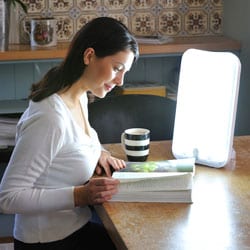
- SAD light therapy boxes.
Although these are recommended to use during the first few hours after waking up in the morning they are not alarm clocks.
Sometimes, when talking about winter depression, people are referring to artificial dawn alarm clocks a.k.a. wake up lights.
These can help a little bit with seasonal affective disorder but are different from a SAD light box.
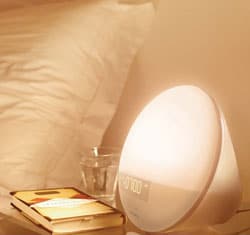
2. Wake up lights (artificial dawn alarm clocks or dawn simulators)
These are bedside lights that wake you up by gradually emitting a stronger light. By simulating naturally in intensity increasing sunrise light they wake you more naturally, from a lighter sleep phase which has all kinds of benefits.
SAD sufferers often use wake up lights in conjunction with a SAD light but the first doesn’t function as a full-fledged winter depression treatment device.
Keep in mind that when products are advertised as SAD sunrise alarm clocks they are probably not the item you’re looking for.
Editor’s note: This publication has been updated since it was originally published in February 2016.
Here’s how to sleep better at night during winter
Similar to exposing yourself to artificial daylight it is crucial to shield yourself from energizing blue light during the evening.
Computers, smartphones and other electronic devices emit this awakening blue spectrum light and thus keep us up. Make sure to block the blue light that is interfering with a healthy Circadian rhythm.
Often used in combination with SAD therapy lamps:
Overview of the best sleep improvement products:
Last Updated on April 8, 2021 by Tyler

